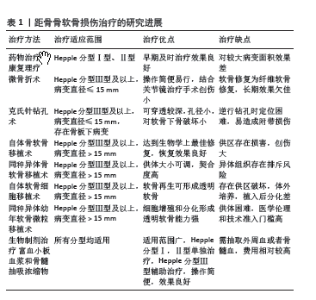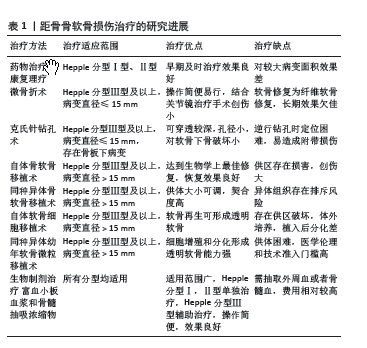Chinese Journal of Tissue Engineering Research ›› 2025, Vol. 29 ›› Issue (21): 4584-4592.doi: 10.12307/2025.818
Previous Articles Next Articles
Personalized combination of treatment options for osteochondral lesions of the talus
Chen Xueming1, She Chang2
- 1Department of Foot and Ankle Surgery, Wuxi Ninth People’s Hospital (Wuxi Ninth Hospital Affiliated to Soochow University), Wuxi 214000, Jiangsu Province, China; 2Department of Orthopedics, Second Affiliated Hospital of Soochow University, Suzhou 215004, Jiangsu Province, China
-
Received:2024-04-15Accepted:2024-07-20Online:2025-07-28Published:2024-12-07 -
Contact:She Chang, MD, Chief physician, Department of Orthopedics, Second Affiliated Hospital of Soochow University, Suzhou 215004, Jiangsu Province, China -
About author:Chen Xueming, Associate chief physician, Department of Foot and Ankle Surgery, Wuxi Ninth People’s Hospital (Wuxi Ninth Hospital Affiliated to Soochow University), Wuxi 214000, Jiangsu Province, China -
Supported by:National Natural Science Foundation of China, No. 82070904 (to SC)
CLC Number:
Cite this article
Chen Xueming, She Chang. Personalized combination of treatment options for osteochondral lesions of the talus[J]. Chinese Journal of Tissue Engineering Research, 2025, 29(21): 4584-4592.
share this article
Add to citation manager EndNote|Reference Manager|ProCite|BibTeX|RefWorks

2.1 距骨骨软骨损伤的损伤机制和分期 踝关节是类似卯榫结构的关节,强调稳定的同时又需在有限的空间内有一定的活动度,其关节软骨相对较薄,承受压力后变形缓冲能力存在一定的局限性[9]。距骨是前宽后窄的解剖结构,当踝关节跖屈时匹配程度最低,距骨软骨接触面积最少,接触面压强最大,同时又是最不稳定的状态,极易损伤。距骨软骨的解剖特性和接触应力时的缓冲方式解释了距骨骨软骨损伤的发生机制[10]。在急性损伤中,直接的创伤应力会导致距骨软骨或软骨下骨的骨折,破坏软骨下骨的血液循环;而在慢性损伤中,踝关节力线不正会导致距骨软骨负荷不均,这在距骨骨软骨损伤的发生和发展过程中扮演着重要角色[9]。LLOYD等[11]的研究结果表明,踝穴内距骨移动仅1 mm,会致使距骨与胫骨远端关节面的接触面积明显减少,距骨单位接触面积的应力显著增加。此外,距骨软骨下骨板的完整与否与距骨软骨修复的远期效果紧密相关。KOCH等[12]指出,损伤应力主要作用于软骨下骨板周围。丧失完整性的软骨下骨板对距骨骨软骨损伤的愈合具有负面影响,可能导致病情恶化。距骨软骨下囊肿的形成可能与受损软骨所呈现的瓣膜状功能有关,这一病理过程通常在距骨软骨发生小直径损伤时出现。距骨软骨下骨囊肿的形成,是多种因素共同作用的结果,这些因素包括损伤的具体类型、关节的匹配度、力线的状态、碰撞力的强度以及剪应力的影响。在特定区域,关节液的高压力与pH值的降低可能诱发疼痛感受。由于软骨下骨富含神经支配,其对刺激的反应变得更为敏锐,从而增加了患者感受到疼痛的可能性[13-14]。 BERNDT等[15]认为,距骨骨软骨损伤是与创伤相关的跨软骨骨折,并根据X射线片表现提出距骨骨软骨损伤的4个分期和分型:①骨软骨挫伤;②骨软骨不完全骨折;③骨软骨完全骨折、无移位;④骨软骨完全骨折、移位。HEPPLE等[16]提出距骨骨软骨损伤MRI表现分期并以此来分型:Ⅰ期,仅有关节软骨损伤;Ⅱa 期,关节软骨损伤,伴有软骨下骨折和周围骨髓水肿;Ⅱb期,关节软骨损伤,伴有软骨下骨折,无周围骨髓水肿;Ⅲ期,骨碎片分离,但无移位;Ⅳ期,骨碎片分离,有移位;Ⅴ期,关节软骨下囊肿形成。根据影像来分期和分型存在不足,关节镜下诊断为金标准。FERKEL等[17]基于关节镜下距骨软骨的表现,将距骨骨软骨损伤划分为6个不同阶段并以此分型,具体而言,A期表现为软骨光滑并完整,具有柔软或漂浮的触感;B期则表现为软骨表面粗糙;C期软骨出现纤维化并伴随有裂隙;D期则表现为软骨块或软骨下骨开始外露;E期特征为软骨变得疏松,但并未出现移位的碎骨块;F期则表现为存在移位的碎骨块。根据关节镜下表现分期对于理解和评估软骨损伤有一定帮助,其缺点为有创检查,并且仅专注于软骨本身的损伤情况,而忽视了软骨下骨可能存在的表现与变化。综合上述距骨骨软骨损伤的几种分期和分型,目前临床上应用Hepple分期分型较为普遍。 2.2 治疗选择与预后评估 保守治疗:对于轻度损伤或早期损伤的患者,Hepple分型Ⅰ型和Ⅱ型,可以采用保守治疗,如休息、固定、患肢部分负重等,有助于减轻关节压力,促进软骨修复。 康复理疗:如冲击波治疗、磁疗等,其中冲击波物理疗法,对缓解疼痛和促进软骨修复已有明确疗效[18]。 药物治疗:使用非类固醇抗炎药和氨基葡萄糖,对于疼痛明显或伴炎症表现的患者,可以减轻炎症,缓解疼痛,促进软骨修复[19]。 手术治疗:对于保守治疗无效或Hepple分型Ⅲ型及以上的患者可能需要采取手术治疗。手术方法包括骨髓刺激(微骨折和克氏针钻孔)、骨软骨移植(自体和同种异体骨软骨移植)、软骨细胞移植(自体和同种异体软骨细胞移植)、生物制剂治疗(富血小板血浆和骨髓抽吸浓缩物)等,其中软骨细胞移植治疗和生物制剂治疗属于组织工程范畴,具体方法需根据距骨骨软骨病变具体情况和医生的建议来确定[19]。 预后评估:通过X射线片、MRI等影像学检查可以观察距骨骨软骨损伤的恢复情况,包括软骨的修复程度、关节间隙的变化等[20]。通过评估患者的关节活动度、肌力、步态等,可以了解患者的功能恢复情况。此外,还可以使用评分系统,如美国足踝外科医师协会踝关节功能评分,对患者的功能恢复进行量化评估。通过患者自我报告的疼痛目测类比评分,可以了解患者的疼痛程度及其变化,疼痛减轻或消失是预后良好的重要指标之一。 总而言之,距骨骨软骨损伤的治疗选择和预后评估是一个个体化的过程,需要综合考虑患者的具体情况和医生的建议。在治疗过程中,患者应积极配合医生的治疗方案,并进行定期的复查和评估,以便及时调整治疗方案,达到最佳的治疗效果。见表1。"


2.3 保守治疗进展 2.3.1 急性损伤保守治疗 急性损伤的治疗主要包括休息、制动、物理治疗以及药物治疗。这些方法主要适用于由急性踝关节扭伤导致的、病程少于6周的Hepple分型Ⅰ,Ⅱ型距骨骨软骨损伤。这些治疗均为踝关节扭伤的常规疗法,包括让患者休息并抬高患肢以减轻肿胀,早期采用石膏或支具外固定制动来防止损伤进一步恶化,以及通过物理治疗和药物治疗来减轻肿胀和无菌性炎症引发的疼痛。这些治疗方法能够减轻临床症状和缓解病情。BADEKAS等[21]的研究显示,在Berndt和Hardy分型Ⅰ,Ⅱ型以及Hepple分型Ⅰ,Ⅱ型的距骨骨软骨损伤患者中,经过3-12周的保守治疗,大部分患者能够有效缓解临床症状。 对Hepple分型Ⅲ型及以上保守治疗疗效有限,保守治疗的有效率仅在20%左右[22]。据SHEARER等[23]的报告,仅有24%的距骨骨软骨损伤伴囊性变患者通过保守治疗取得了的部分疗效。但对于Hepple分型Ⅲ型及以上的儿童和小于20岁青少年采用保守治疗较为普遍,相对于成年人,距骨骨软骨损伤自愈率高[24]。另外,体质量指数也是需要考虑的因素,D′AMBROSI等[25]的研究指出,位于距骨中央的骨软骨损伤,其病变大小会随着患者体质量指数的增加而增大,且踝关节症状往往会随之逐渐加重。 即使对距骨骨软骨损伤患者进行手术治疗之前,也通常会选择一段时间的保守治疗,保守治疗的疗效观察期限为6个月。主要适用于那些无症状、症状轻微或偶发性损伤的距骨骨软骨损伤患者,以及骨骼发育尚未完全成熟的患者和Berndt和Harty分型以及Hepple分型较低的患者[26-27]。 值得注意的是,不同的研究团队在保守治疗方法上存在一定差异。例如,ZENGERINK等[28]主张患者休息并禁止活动,配合使用药物治疗,其成功率为45%。而TOL等[24]则推荐三四周支具固定下免负重活动,其成功率为59%,其中优良率可达41%。对于Hepple分型Ⅳ型的患者,EASLEY等[29]的保守治疗效果较差,仅有14%的患者获得了较好的疗效。另外,SHEARER等[30]的研究显示,距骨骨软骨损伤患者的保守治疗失败率偏高。若患者症状持续并逐渐加重,手术治疗或许成为必要之选,特别是对于那些年龄小于20岁、损伤位于距骨穹窿内侧、影像学检查显示损伤明显进展的患者,保守治疗的预后往往提示不佳。因此,哪些距骨骨软骨损伤患者能选择保守治疗,仍是一个值得深入探讨的课题。 2.3.2 慢性损伤保守治疗 距骨骨软骨损伤慢性损伤是指急性损伤后超过 6 周,踝关节仍存在疼痛、活动受限,包括有(无)明确创伤史的距骨骨软骨损伤[31]。患者应避免过度使用或过度负荷受损的距骨,通过休息来减轻症状,并为软骨组织的修复提供有利条件。药物治疗在保守治疗中占据重要地位,常用药物包括非类固醇抗炎药(如布洛芬、吲哚美辛等),用于减轻疼痛和炎症反应;以及软骨修复药物(如氨基葡萄糖、软骨素等),用于促进软骨组织的再生和修复。目前对慢性损伤的非手术治疗方法包括体外冲击波及关节内注射生物制剂。体外冲击波治疗已被证实在骨缺损修复中发挥作用,LYON等[32]的研究揭示了其对兔子膝关节软骨损伤具有修复效果。有研究表明在临床实践中观察了体外冲击波治疗对Hepple分型Ⅳ型以下的距骨骨软骨损伤患者的疗效,经过12个月的治疗,患者的疼痛目测类比评分显著降低,美国足踝外科医师协会踝关节功能评分则明显升高,MRI检查显示软骨损伤面积明显缩小[33]。尽管体外冲击波治疗在距骨骨软骨损伤中展现出一定的临床效果,但仍需长期且广泛的临床观察来进一步验证其疗效。 2.4 手术治疗进展 Hepple分型Ⅲ型及以上的患者通常选择手术治疗,保守治疗未能取得理想效果时也会被考虑,包括保守治疗失败、疼痛症状一直未解除的患者。现有的手术策略主要有修复、移植和再生策略,修复策略为骨髓刺激、微骨折术及克氏针钻孔术;移植策略包括自体骨软骨移植和同种异体骨软骨移植;再生策略有自体骨软骨细胞移植和同种异体幼年软骨微粒移植。手术方式上有传统的开放手术和关节镜手术,传统的开放手术因可能带来的愈合延迟和关节韧带粘连等风险,使得关节镜手术逐渐成为治疗该疾病的首选方法,但关节镜也有其缺点,如踝关节后侧难以显露、视野小暴露不清、关节腔间隙小操作空间有限和学习曲线长等,开放手术仍不可或缺。手术治疗要点:①病变软骨判断和病损的清理;②骨髓刺激要充分考虑软骨修复;③骨软骨移植物的有效固定;④生物制剂的辅助使用[34]。 2.4.1 微骨折术 微骨折术已成为治疗距骨骨软骨损伤的常用修复手术技术。在关节镜的辅助下,微骨折操作能够精准穿透软骨下骨,有效激发骨髓释放丰富的有益成分,包括营养物质、生长因子以及骨髓间充质干细胞,从而为损伤部位提供必要的修复与支持[35]。这些有益物质能够精准填充到软骨损伤部位,进而促使骨髓间充质干细胞分化为软骨细胞。这些新生的软骨细胞会逐渐形成纤维软骨,替代受损的透明软骨,从而实现软骨缺损的修复。该方法特别适用于病灶面积小于150 mm2或直径小于 15 mm的病变,因其术后恢复迅速、成本低廉、手术操作简便、成功率高且复发风险低等特点,得到了广泛的认可与应用[36]。 骨髓刺激的原理是允许软骨缺损部位的间充质干细胞浸润,这可以通过微压裂或钻井来实现。在微骨折术中,用手术锥子以3.0-4.0 mm的间隔破坏软骨下板,直到观察到骨髓中出现脂肪滴,使用外科钻头或金属丝钻孔也会引起同样的过程。在这两种情况下,纤维蛋白凝块在治疗缺陷内形成,引发炎症反应,随后释放细胞因子和生长因子来刺激愈合过程[37]。当多能骨髓间充质干细胞迁移到血栓中并开始分化和增殖时,形成纤维软骨型修复组织,其细胞外基质最初含有Ⅱ型胶原(研究表明这种结构最终转化为瘢痕组织,以Ⅰ型胶原为主,Ⅱ型胶原水平降低)。骨髓刺激治疗距骨骨软骨损伤可以通过微创技术进行,它的并发症发生率低,术后疼痛最小,并且可能比其他技术要求更低[37-38]。 骨髓刺激的适应证至今仍不明确。在文献中,距骨骨软骨损伤直径< 15 mm的微骨折主要取得了良好的效果。CHUKPAIWONG等[39]对105个踝关节进行了微骨折治疗,将成功治疗定义为满足以下4个标准中的3个:①日常活动中疼痛的目测类比评分改善50%以上;②运动中疼痛的目测类比评分改善50%以上;③美国足踝外科医师协会踝关节功能评分提高至少30分;④Roles和Maudsley评分为1或2分。在接受治疗的105个踝关节中,所有73个直径小于15 mm的病变都符合成功预后的标准;然而,直径大于15 mm的病灶只有1/32符合成功标准,直径大于20 mm的24个病灶无一成功。CHOI等[40]同样发现病变大小可预测微骨折手术后的预后,在他们对120例踝关节微骨折的分析中,发现病变直径大于15 mm 预示着不良的预后,小于这个阈值的病灶治疗失败率为10.5%,直径大于15 mm的病灶80%符合治疗失败的标准。YANG等[41]报道了35例踝关节(所有患者年龄小于50岁),在平均随访33个月的时间里,孤立距骨病变直径< 15 mm进行了微骨折;根据美国足踝外科医师协会踝关节功能评分,89%报告为良好或极好,11%报告为一般,美国足踝外科医师协会踝关节功能评分平均提高27分,疼痛目测类比评分平均降低5分。CLANTON等[42]对Outerbridge 3级和4级软骨病变进行微骨折后平均随访26个月,患者足踝残疾指数中日常生活活动81分,运动 62分,平均患者满意度为8分(满分10分),这明显好于之前接受过踝关节手术的患者和受伤至手术间隔时间较长的患者。 多项研究表明,微骨折术在治疗距骨骨软骨损伤方面取得了显著成果。例如,YANG等[41]对软骨损伤面积直径小于15 mm的患者进行微骨折术治疗,并在33个月后随访,结果显示美国足踝外科医师协会踝关节功能评分的优良率高达89%。CHOI等[40]对距骨骨软骨损伤患者微骨折术后进行了长达六七年的平均随访,发现治疗成功率达到了85%,关节功能和生活质量均得到了明显改善。然而,微骨折术形成的软骨本质上是纤维软骨,与天然透明软骨相比,其质量有所不足。YANG等[41]研究发现,术后平均3.6年,有36%的距骨骨软骨损伤未完全愈合。此外,微骨折过程中软骨下骨的损伤可能改变踝关节的负荷支持,且修复后的纤维软骨随时间推移会降解,导致长期效果受限。软骨下骨髓水肿也可能影响微骨折术的疗效,存在此类情况的患者预后较差。综上所述,虽然微骨折术治疗距骨骨软骨损伤的中长期效果普遍较好,但其修复的纤维软骨在长期的稳定性方面仍需加强。此外,微骨折术主要适用于较小的软骨损伤。因此,在选择手术方式时,必须全面考虑患者的具体病情,例如,当存在软骨下骨髓水肿等状况时,对微骨折术的选择应持谨慎态度。 2.4.2 克氏针钻孔术 克氏针因其直径的可调性以及在钻孔时能够灵活调整方向的特性,已在关节骨软骨损伤的关节镜手术中得到了广泛应用[43]。钻孔术与微骨折术原理相似,但因钻孔更深、形成的软骨下血肿较大且进入孔中的骨髓间充质干细胞数量增加,所以理论上钻孔术后软骨缺损处愈合能力高于微骨折术[43]。此外,克氏针的独特之处在于它能够直接穿透皮肤及皮下组织,直达损伤部位,无需进行大面积的组织暴露或切口,因此能更迅速、高效地处理那些难以暴露的软骨损伤区域[44]。例如关节镜难以显露距骨穹窿后侧,可采用术中透视定位下逆行钻孔技术。然而,在使用克氏针进行钻孔操作时,需要特别注意避免活动角度过大,以免对周围组织造成不必要的医源性损伤。研究表明,克氏针在控制钻孔深度方面展现出了较高的灵活性。对于骨质较厚的部位,通过增加钻孔深度,可以有效地刺激骨髓释放,促进损伤修复[45]。然而,克氏针在钻孔过程中产生的热量也是一个需要关注的问题。过高的热量可能引发周围骨组织的坏死,导致持续性疼痛、水肿等不良反应,甚至可能引发应力性骨折,还会沿钻孔隧道引发医源性骨囊变且在软骨表面留下较大钻孔[46]。因此,在使用克氏针进行手术时,必须严格控制操作过程,确保手术的安全性和有效性。 CHOI等[40]提出低速+冲洗的顺行钻孔技术以最大程度减少热量,但也无法完全解决上述问题,临床应用也显示该技术未表现出优于微骨折术的临床结局。为此,临床应谨慎使用顺行钻孔术治疗距骨骨软骨损伤,与之相比,更推荐使用微骨折术,因为后者不仅能避免热量产生和钻孔问题,操作也较简便。 2.4.3 骨软骨移植术 骨软骨移植技术(自体骨移植或同种异体骨移植)通常用于较大的病变、囊性病变或在先前刮除或钻孔失败的情况下。与骨髓刺激相比,骨软骨移植技术通常适用于大的原发性距骨骨软骨损伤。这些移植物可以是自体的,也可以来自同种异体供者,可以作为单个或多个(马赛克成形术)植入[47]。自体移植的目的是植入与患者自身透明软骨在力学和生物学特性上相似的移植物,自体移植物最常见于同侧膝关节,特别是股骨外侧髁或髁间切迹[48]。据几项研究报道,自体骨软骨移植的主要问题是供体部位的发病率[49-50]。回顾性病例系列显示自体骨软骨移植的积极结果[51]。IMHOFF等[52]观察到26例患者的平均美国足踝外科医师协会踝关节功能评分、疼痛目测类比评分有显著的长期改善;在平均7年的随访时间中,18例患者表示对手术非常满意,4例满意,3例一般,1例中等不满意在其他文献研究中也报道了类似的短期改善,平均病变大小为150 mm2 [53]。SCRANTON等[54]报道的50例囊性距骨缺损患者中有45例接受自体骨软骨移植,平均随访36个月,美国足踝外科医师协会踝关节功能评分良好或优异;只有1例患者在手术后12周因供体部位疼痛而接受治疗,并在手术清创瘢痕组织后症状消失。 除了评估临床结果外,一些研究还利用关节镜来评估移植物的状况和随访时的结合情况。2003年,LEE等[55]纳入平均随访36个月的18例Berndt和Harty Ⅲ,Ⅳ型距骨骨软骨损伤患者,均采用同侧膝关节自体骨软骨置换术治疗,18例患者中有16例进行了二次关节镜检查,其中14例显示了移植物一致性,只有2个移植物表现出软骨软化或开裂,这些结果可能受到患者平均年龄低(22.7岁)和平均病变面积小(13.6 mm×7.2 mm)的积极影响。KREUZ等[56]评估了一组手术治疗距骨骨软骨损伤失败患者的同侧距骨自体移植物移植,他们发现35例患者术后平均4年的美国足踝外科医师协会踝关节功能评分均有显著改善,还发现未行截骨术、踝骨截骨术或胫骨楔形截骨术(当时的新技术)的亚组之间存在显著差异,报告得分分别为94.1,84.7和88.6分;术后1年和2年的MRI显示除1例患者外,所有患者移植物融合良好,关节面一致;他们得出结论,移植物整合良好、截骨愈合良好、关节功能良好的患者可以在长期随访中保持良好的效果。因此,在术后初期监测移植物结合情况是必要的,他们指出,术后过早负重可能导致软骨下床运动,是移植物失败的潜在原因。 EL-RASHIDY等[57]在42例踝关节(38例为距骨骨软骨损伤,平均病变大小为150 mm2)中使用新鲜骨软骨移植,平均随访37.7个月,评估美国足踝外科医师协会踝关节功能评分和疼痛目测类比评分;38例距骨骨软骨损伤患者中有7例术后需要二次关节镜手术,42例移植物中有4例失败;平均疼痛目测类比评分从术前平均8.2分下降到最终随访时的3.3分(P < 0.001);平均美国足踝外科医师协会踝关节功能评分由术前的52.3分显著提高至术后的78.8分(P < 0.001);总体而言,在最后的随访中,73%的患者满意度为优秀、非常好或良好,一般或较差的患者仅为27%;15例患者术后平均33个月进行了MRI检查,其中12例患者的移植物融合被评为一般或较差,5例患者出现移植物不稳定的迹象,1例患者发现移植物下沉;15例患者中10例关节吻合良好,4例软骨接触稍有不规则。较差的MRI结果是否预示较差的临床结果尚不清楚。 在G?RTZ等[58]的一项研究中用新鲜同种异体移植物治疗距骨骨软骨损伤,12例移植物中仅有2例失败,平均随访时间38个月;在其余10例患者中,美国足踝外科医师协会踝关节功能评分从术前的平均28分增加到术后的71分;在随访中,10例患者中有5例报告了良好或极好的结果;X射线影像(12个踝关节中有5个可用)显示只有1个踝关节关节间隙狭窄25%,其余4个踝关节关节间隙保留;80%的患者报告疼痛减轻,60%的患者报告功能改善虽然同种异体移植物移植后患者的预后良好,但它仍然不是解决问题的完美方法。 HAHN等[59]报道对13例患者平均随访48个月,67例患者美国足踝外科医师协会踝关节功能评分从术前平均45分增加到术后平均81分(平均病变面积267 mm2);所有患者在手术1年内都能恢复到以前的活动状态,均对手术表示满意。然而,与G?RTZ等[58]的研究相反,X射线片显示除1例患者外,其余患者均有骨赘,另外2例患者有轻微的关节炎改变;CT扫描显示,2例患者的愈合不到50%,这表明在某种程度上,同种异体移植可能只是推迟了不可避免的治疗。同样,RAIKIN[60]的研究中,同种异体移植患者术前的美国足踝外科医师协会踝关节功能评分为68分,平均为38分;术后平均随访54个月,美国足踝外科医师协会踝关节功能评分为83分,与治疗前相比差异有显著性意义(P < 0.05);术前疼痛目测类比评分平均8.5分,术后随访平均3.3分。同种异体移植治疗距骨骨软骨损伤已被证明是临床有效的,大多数患者似乎对结果感到满意。虽然同种异体移植有助于恢复关节功能,减轻疼痛,并允许患者恢复以前的活动,但应该注意的是,该方法并不能完全阻止退行性关节炎变化的发展。 2.5 生物制剂治疗 关节软骨修复能力有限,大的缺损往往难以自然愈合,需及时干预以避免骨关节炎发生。但当前大面积软骨损伤的治疗并不理想,自体移植受限于组织可用性和供体部位发病率,而异体移植则可能面临移植排斥问题。组织工程治疗软骨缺损前景广阔,但仍存诸多挑战。天然材料虽免疫原性有限,但存在动物病原体传播风险,且机械性能不足;合成材料则缺乏细胞黏附位点,水解降解可能导致局部pH值变化和炎症。结合天然与合成材料的支架在活体研究中效果亦不佳,其生物安全性和有效性备受关注。因此,从患者自身组织获取支架成为安全可靠的选择[61]。 在距骨骨软骨损伤的治疗领域,生物制剂的应用正逐渐崭露头角,其中富含血小板血浆、骨髓抽吸浓缩物和间充质干细胞等生物制剂不仅可用于距骨骨软骨损伤的保守治疗,还可作为手术的辅助治疗手段,展现出了广泛的应用前景。HANNON等[47]的研究显示,包括富血小板血浆和骨髓抽吸浓缩物在内的生物活性因子已被证明能够促进软骨再生,但这一结论仍需要长期的临床研究来加以支持和验证。 富血小板血浆是一种含有浓缩血小板的自体血液制品。经过凝血酶或氯化钙的激活作用,富血小板血浆中的血小板会进行脱粒,进而释放出一系列生长因子,包括血小板衍生生长因子、转化生长因子、胰岛素样生长因子、表皮生长因子、血管内皮生长因子以及其他多种生长因子,这些生长因子在释放后能够发挥各自的生物活性,参与组织的修复与再生过程。在软骨形成或软骨细胞分化期间,转化生长因子β诱导骨髓源性干细胞的软骨形成,而血小板衍生生长因子帮助软骨细胞保持透明样软骨表型并促进增殖和蛋白聚糖合成。在之前的研究中证明了富血小板血浆凝胶为软骨修复提供了一种多孔的生物活性支架[48,61]。 研究表明,富血小板血浆能促进软骨细胞和骨髓间充质干细胞的增殖,增加蛋白多糖和Ⅱ型胶原的沉积,同时抑制局部细胞因子的分解代谢作用[61]。MEI-DAN等[62]的实验结果显示,相较于辅助性透明质酸注射,微骨折后接受富血小板血浆治疗的距骨骨软骨损伤患者在术后28周取得了更佳的效果,具体表现为美国足踝外科医师协会踝关节功能评分升高、疼痛目测类比评分和关节僵硬度降低,踝关节功能得到明显改善,且患者的主观功能评分也有所提升。GUNEY等[63]的比较研究显示,相较于仅接受关节镜下微骨折治疗的患者,接受微骨折与富血小板血浆联合治疗的距骨骨软骨损伤患者在踝关节功能上获得了更大的改善。DORAL等[64]在一项随机对照临床试验中发现,微骨折术后每周注射透明质酸,术后2年随访患者的美国足踝外科医师协会踝关节功能评分显著高于单纯接受微骨折治疗的患者。 骨髓抽吸浓缩物是通过采集骨髓(通常取自髂嵴)并进行离心处理得到的浓缩产物,它富含骨髓间充质干细胞、生长因子和细胞因子,因此在软骨修复中具有重要的应用价值[61]。多项临床研究表明,骨髓抽吸浓缩物能够显著提高软骨修复的质量。HANNON等[47]的研究显示,尽管在关节镜下使用微骨折和克氏针钻孔术治疗时,辅助骨髓抽吸浓缩物并未显著提升功能评分,但骨髓抽吸浓缩物优化了修复组织及其成分间的联系,减少了MRI检查中观察到的组织间裂隙和纤维化现象。此外,脂肪干细胞因其在脂肪组织中的高浓度及分化为软骨细胞的潜力而受到广泛关注,这些细胞在脂肪有核细胞中占比达到5%,并展现出强大的增殖能力,从而成为了一种极具吸引力的生物制剂。KIM等[65]的研究对比了微骨折及克氏针钻孔术后使用和不使用脂肪干细胞治疗的患者,发现接受脂肪干细胞辅助治疗的患者在美国足踝外科医师协会踝关节功能评分和疼痛目测类比评分上均明显优于仅接受微骨折和克氏针钻孔治疗的患者。尽管生物制剂对骨髓刺激效果的潜在增强作用已得到临床验证,但关于最佳生物制剂物的选择、使用剂量、释放方式及时间仍需通过深入的随机临床试验来确定。 2.6 组织工程及干细胞治疗在距骨骨软骨损伤中的应用 软骨细胞移植术属于距骨骨软骨损伤手术治疗中的再生策略,组织工程技术及干细胞技术的具体应用具有最佳生物相容性和最佳修复特性,可分为自体软骨细胞移植和同种异体幼年软骨微粒移植。自体软骨细胞移植是首个应用于距骨软骨损伤临床治疗的细胞疗法,此疗法通过从非功能性透明软骨区域采集少量软骨细胞,进行体外培养后,再将其重新注入受损部位[43]。目前国外已开展第3代自体软骨细胞移植技术,用组织工程技术制作的三维支架基质混合自体软骨细胞植入软骨缺损区域,由该基质直接诱导透明软骨细胞的生长和增殖,而无需在体外培养;但其仍然存在诸多不确定因素,如基质的固定、软骨细胞的流失和分化增殖的困难。 同种异体幼年软骨微粒移植术具有良好的效果在基础研究中已获得证实,在国外已经应用于距骨骨软骨损伤的治疗。同种异体幼年软骨微粒抗原性弱,体内移植排斥反应小,具有较强的软骨细胞增殖能力和分化成透明软骨的能力。同种异体幼年软骨微粒术在关节镜下可行一期手术治疗,其潜在的优越性能已逐渐被医生及患者接受;然而临床以早期疗效为主,缺少远期随访的报道,同种异体幼年软骨微粒也存在移植物加工过程污染、疾病传播的风险。该疗法目前国内临床应用上仍面临诸多挑战,如技术准入制度及伦理问题,尚未能开展应用。 相比之下,间充质干细胞移植在软骨修复方面展现出更大的潜力。间充质干细胞是针对病变直径大于15 mm的较大病灶或替代疗法失败而描述的一种治疗方法,其优势主要体现在以下几个方面:间充质干细胞在人体多个组织如骨髓、脂肪和滑膜中均有分布,易于获取且不会对供区造成损伤;其强大的增殖能力和分化为软骨细胞的潜力,使得间充质干细胞在治疗距骨软骨损伤方面具有显著优势;此外,这些细胞不表达主要组织相容性复合物和免疫刺激分子,因此能够避免免疫系统的监测,减少移植排斥反应的风险,为同种异体细胞治疗提供了可能;最后,间充质干细胞还具备独特的归巢特性,能够自发地向损伤区域聚集,从而提高治疗效果[66]。 临床和动物实验显示,单纯细胞输注在修复大面积距骨软骨损伤时面临挑战,但组织工程技术的持续进步为治疗策略开辟了新的途径。在组织工程修复软骨的过程中,支架、种子细胞和生长因子是关键的三要素。尤其是具备生物活性的3D支架,如水凝胶和3D多孔支架等,它们不断得到优化和革新,为软骨组织的生长提供了不可或缺的3D微环境。此外,生长因子如骨形态发生蛋白2、胰岛素样生长因子Ⅰ等,能够诱导并增强软骨细胞的分化和软骨的形成。除了这些,还涌现出了一些性质更稳定的小分子药物,它们能够促进软骨细胞的生成并具有软骨保护作用[67]。 "

| [1] 杨帅, 连勇, 胡长青, 等. 不同关节镜术式对小面积距骨骨软骨损伤患者疗效及安全性的影响[J], 医学综述,2021,27(11):2274-2278. [2] LOOZE CA, CAPO J, RYAN MK, et al. Evaluation and Management of Osteochondral Lesions of the Talus. Cartilage. 2016;8(1):19-30. [3] SEO SG, KIM JS, SEO D, et al. Osteochondral lesions of the talus Acta Orthopaedica. 2018;89(4):462-467. [4] HURLEY ET, STEWART SK, KENNEDY JG, et al. Current management strategies for osteochondral lesions of the talus. Bone Joint J. 2021; 103-B(2): 207-212. [5] MANN TS, NERY C. Osteochondral Lesion of the Talus: Quality of Life, Lesion Site, and Lesion Size. Foot Ankle Clin. 2024;29(2):213-224. [6] BAI L, ZHANG Y, CHEN S, et al. Analysis of factors affecting the prognosis of osteochondral lesions of the talus. Int Orthop. 2023; 47(3):861-871 [7] MURPHY EP, MCGOLDRICK NP, CURTIN M, et al. A prospective evaluation of bone marrow aspirate concentrate and microfracture in the treatment of osteochondral lesions of the talus. Foot Ankle Surg. 2019;25(4):441-448 [8] WAN DD, HUANG H, HU MZ, et al. Results of the osteochondral autologous transplantation for treatment of osteochondral lesions of the talus with harvesting from the ipsilateral talar articular facets. Int Orthop. 2022;46(7):1547-1555. [9] 温纪林, 李莹. 距骨骨软骨损伤的研究进展[J]. 骨科临床与研究杂志,2023,8(3):179-186. [10] WILLIAMSON P, LECHTIG A, HANNA P, et al. Pressure Distribution in the Ankle and Subtalar Joint With Routine and Oversized Foot Orthoses. Foot Ankle Int. 2018;39(8):994-1000. [11] LLOYD J, ELSAYED S, HARIHARAN K, et al. Revisiting the concept of talar shift in ankle fractures. Foot Ankle Int. 2006;27(10):793-796. [12] KOCH S, KAMPEN WU, LAPRELL H. Cartilage and bone morphology in osteochondritis dissecans. Knee Surg Sports Traumatol Arthrosc. 1997;5(1):42-45. [13] QIU YS, SHAHGALDI BF, REVELL WJ, et al. Observations of subchondral plate advancement during osteochondral repair: a histomorphometric and mechanical study in the rabbit femoral condyle. Osteoarthritis Cartilage. 2003;11(11):810-820. [14] DÜRR HD, MARTIN H, PELLENGAHR C, et al. The cause of subchondral bone cysts in osteoarthrosis: a finite element analysis. Acta Orthop Scand. 2004;75(5):554-558. [15] BERNDT AL, HARTY M. Transchondral fractures (osteochondritis dissecans) of the talus. J Bone Joint Surg Am. 2004;86(6):1336. [16] HEPPLE S, WINSON IG, GLEW D. Osteochondral lesions of the talus: a revised classification. Foot Ankle Int. 1999;20(12):789-793. [17] FERKEL RD, ZANOTTI RM, KOMENDA GA, et al. Arthroscopic treatment of chronic osteochondral lesions of the talus: long-term results. Am J Sports Med. 2008;36(9):1750-1762. [18] ZHANG C, HUANG H, YANG L, et al. Extracorporeal Shock Wave Therapy for Pain Relief After Arthroscopic Treatment of Osteochondral Lesions of Talus. J Foot Ankle Surg. 2020;59(1):190-194. [19] LIU S. Current Concepts in Clinical Treatment of Osteochondral Lesions of the Talus. Highlights Sci Eng Technol. 2023;54: 80-86. [20] GIANAKOS AL, YASUI Y, HANNON CP, et al. Current management of talar osteochondral lesions. World J Orthop. 2017;8(1):12-20. [21] BADEKAS T, TAKVORIAN M, SOURAS N. Treatment principles for osteochondral lesions in foot and ankle. Int Orthop. 2013;37(9): 1697-1706. [22] EASLEY ME, SCRANTON PE JR. Osteochondral autologous transfer system. Foot Ankle Clin. 2003;8(2):275-290. [23] SHEARER C, LOOMER R, CLEMENT D. Nonoperatively managed stage 5 osteochondral talar lesions. Foot Ankle Int. 2002;23(7): 651-654. [24] TOL JL, STRUIJS PA, BOSSUYT PM, et al. Treatment strategies in osteochondral defects of the talar dome: a systematic review. Foot Ankle Int. 2000;21(2):119-126. [25] D’AMBROSI R, MACCARIO C, SERRA N, et al. Relationship between symptomatic osteochondral lesions of the talus and quality of life, body mass index, age, size and anatomic location. Foot Ankle Surg. 2018;24(4):365-372. [26] BAUMS MH, SCHULTZ W, KOSTUJ T, et al. Cartilage repair techniques of the talus: An update. World J Orthop. 2014;5(3):171-179. [27] KLAMMER G, MAQUIEIRA GJ, SPAHN S, et al. Natural history of nonoperatively treated osteochondral lesions of the talus. Foot Ankle Int. 2015;36(1):24-31. [28] ZENGERINK M, STRUIJS PA, TOL JL, et al. Treatment of osteochondral lesions of the talus: a systematic review. Knee Surg Sports Traumatol Arthrosc. 2010;18(2):238-246. [29] EASLEY ME, SCRANTON PE JR. Osteochondral autologous transfer system. Foot Ankle Clin. 2003;8(2):275-290. [30] SHEARER C, LOOMER R, CLEMENT D. Nonoperatively managed stage 5 osteochondral talar lesions. Foot Ankle Int. 2002;23(7):651-654. [31] 刘江,邰东旭.中西医治疗距骨骨软骨损伤临床研究进展[J].江西中医药,2019,50(7):77-80. [32] LYON R, LIU XC, KUBIN M, et al. Does extracorporeal shock wave therapy enhance healing of osteochondritis dissecans of the rabbit knee: a pilot study. Clin Orthop Relat Res. 2013;471(4):1159-1165. [33] 刘水涛,杨军,史展,等.发散式体外冲击波治疗距骨骨软骨损伤的效果[J].武警医学,2017,28(7):694-697. [34] ZENGERINK M, SZERB I, HANGODY L, et al. Current concepts: treatment of osteochondral ankle defects. Foot Ankle Clin. 2006;11(2):331-359, vi. [35] 杨蕊菲,高铭鸿,秦雪萌,等.关节镜下微骨折术联合富血小板血浆治疗距骨软骨损伤研究进展[J].临床军医杂志,2023,51(7): 768-770. [36] 徐明明,张焱,刘云鹏.镜下微骨折联合富血小板血浆治疗距骨软骨损伤[J].中国矫形外科杂志,2021,29(6):548-551. [37] BRUNS J, HABERMANN C, WERNER M. Osteochondral Lesions of the Talus: A Review on Talus Osteochondral Injuries, Including Osteochondritis Dissecans. Cartilage. 2021;13(1_suppl): 1380S-1401S. [38] BAE DK, YOON KH, SONG SJ. Cartilage healing after microfracture in osteoarthritic knees. Arthroscopy. 2006;22(4):367-374. [39] CHUCKPAIWONG B, BERKSON EM, THEODORE GH. Microfracture for osteochondral lesions of the ankle: outcome analysis and outcome predictors of 105 cases. Arthroscopy. 2008;24(1):106-112. [40] CHOI WJ, PARK KK, KIM BS, et al. Osteochondral lesion of the talus: is there a critical defect size for poor outcome? Am J Sports Med. 2009;37(10):1974-1980. [41] YANG HY, LEE KB. Arthroscopic Microfracture for Osteochondral Lesions of the Talus: Second-Look Arthroscopic and Magnetic Resonance Analysis of Cartilage Repair Tissue Outcomes. J Bone Joint Surg Am. 2020;102(1):10-20. [42] CLANTON TO, JOHNSON NS, MATHENY LM. Outcomes Following Microfracture in Grade 3 and 4 Articular Cartilage Lesions of the Ankle. Foot Ankle Int. 2014;35(8):764-770. [43] 蒋宁,徐桂军,李浩民,等.距骨骨软骨损伤的外科治疗进展[J].中国修复重建外科杂志,2024,28(3):373-379. [44] 谢国鑫,刘金豹,梁学振,等.距骨骨软骨损伤的手术治疗研究进展[J].医学综述,2021,27(7):1363-1368. [45] CHOI JI, LEE KB. Comparison of clinical outcomes between arthroscopic subchondral drilling and microfracture for osteochondral lesions of the talus. Knee Surg Sports Traumatol Arthrosc. 2016;24(7):2140-2147. [46] KIM JY, REYES FJ, YI Y, et al. Is Antegrade Transmalleolar Drilling Method for Osteochondral Lesion of Talus Necessary? Iatrogenic Cystic Formation at the Tibia: A Report of Five Cases. Clin Orthop Surg. 2016;8(1):119-122. [47] HANNON CP, SMYTH NA, MURAWSKI CD, et al. Osteochondral lesions of the talus: aspects of current management. Bone Joint J. 2014; 96-B(2):164-171. [48] KENNEDY JG, MURAWSKI CD. The Treatment of Osteochondral Lesions of the Talus with Autologous Osteochondral Transplantation and Bone Marrow Aspirate Concentrate: Surgical Technique. Cartilage. 2011;2(4):327-336. [49] HANGODY L, VÁSÁRHELYI G, HANGODY LR, et al. Autologous osteochondral grafting--technique and long-term results. Injury. 2008;39 Suppl 1:S32-S39. [50] LAPRADE RF, BOTKER JC. Donor-site morbidity after osteochondral autograft transfer procedures. Arthroscopy. 2004;20(7):e69-e73. [51] DE L’ESCALOPIER N, AMOUYEL T, MAINARD D, et al. Long-term outcome for repair of osteochondral lesions of the talus by osteochondral autograft: A series of 56 Mosaicplasties®. Orthop Traumatol Surg Res. 2021;107(8S):103075. [52] IMHOFF AB, PAUL J, OTTINGER B, et al. Osteochondral transplantation of the talus: long-term clinical and magnetic resonance imaging evaluation. Am J Sports Med. 2011;39(7):1487-1493. [53] KIM YS, PARK EH, KIM YC, et al. Factors associated with the clinical outcomes of the osteochondral autograft transfer system in osteochondral lesions of the talus: second-look arthroscopic evaluation. Am J Sports Med. 2012;40(12):2709-2719. [54] SCRANTON PE JR, FREY CC, FEDER KS. Outcome of osteochondral autograft transplantation for type-V cystic osteochondral lesions of the talus. J Bone Joint Surg Br. 2006;88(5):614-619. [55] LEE CH, CHAO KH, HUANG GS, et al. Osteochondral Autografts for Osteochondritis Dissecans of the Talus. Foot Ankle Int. 2003;24(11): 815-822. [56] KREUZ PC, STEINWACHS M, ERGGELET C, et al. Mosaicplasty with autogenous talar autograft for osteochondral lesions of the talus after failed primary arthroscopic management: a prospective study with a 4-year follow-up. Am J Sports Med. 2006;34(1):55-63. [57] EL-RASHIDY H, VILLACIS D, OMAR I, et al. Fresh osteochondral allograft for the treatment of cartilage defects of the talus: a retrospective review. J Bone Joint Surg Am. 2011;93(17): 1634-1640. [58] GÖRTZ S, DE YOUNG AJ, BUGBEE WD. Fresh osteochondral allografting for osteochondral lesions of the talus. Foot Ankle Int. 2010;31(4): 283-290. [59] HAHN DB, AANSTOOS ME, WILKINS RM. Osteochondral lesions of the talus treated with fresh talar allografts. Foot Ankle Int. 2010;31(4): 277-282. [60] RAIKIN SM. Fresh osteochondral allografts for large-volume cystic osteochondral defects of the talus. J Bone Joint Surg Am. 2009;91(12): 2818-2826. [61] LOOZE CA, CAPO J, RYAN MK, et al. Evaluation and Management of Osteochondral Lesions of the Talus. Cartilage. 2017;8(1):19-30. [62] MEI-DAN O, CARMONT MR, LAVER L, et al. Platelet-rich plasma or hyaluronate in the management of osteochondral lesions of the talus. Am J Sports Med. 2012;40(3):534-541. [63] GUNEY A, YURDAKUL E, KARAMAN I, et al. Medium-term outcomes of mosaicplasty versus arthroscopic microfracture with or without platelet-rich plasma in the treatment of osteochondral lesions of the talus. Knee Surg Sports Traumatol Arthrosc. 2016;24(4): 1293-1298. [64] DORAL MN, BILGE O, BATMAZ G, et al. Treatment of osteochondral lesions of the talus with microfracture technique and postoperative hyaluronan injection. Knee Surg Sports Traumatol Arthrosc. 2012; 20(7):1398-1403. [65] KIM YS, LEE HJ, CHOI YJ, et al. Does an injection of a stromal vascular fraction containing adipose-derived mesenchymal stem cells influence the outcomes of marrow stimulation in osteochondral lesions of the talus? A clinical and magnetic resonance imaging study. Am J Sports Med. 2014;42(10):2424-2434. [66] VOLPI P, BAIT C, QUAGLIA A, et al. Autologous collagen-induced chondrogenesis technique (ACIC) for the treatment of chondral lesions of the talus. Knee Surg Sports Traumatol Arthrosc. 2014;22(6):1320-1326. [67] JONES WG, EL-JAWHARI JJ, BROCKETT CL, et al. Multipotential stromal cells in the talus and distal tibia in ankle osteoarthritis - Presence, potency and relationships to subchondral bone changes. J Cell Mol Med. 2021;25(1):259-271. |
| [1] | Lai Pengyu, Liang Ran, Shen Shan. Tissue engineering technology for repairing temporomandibular joint: problems and challenges [J]. Chinese Journal of Tissue Engineering Research, 2025, 29(在线): 1-9. |
| [2] | Liu Lin, Liu Shixuan, Lu Xinyue, Wang Kan. Metabolomic analysis of urine in a rat model of chronic myofascial trigger points [J]. Chinese Journal of Tissue Engineering Research, 2025, 29(8): 1585-1592. |
| [3] | Su Xiaoyang, Chen Wenting, Fu Yidan, Zhao Yan, Lan Danfeng, Yang Qiuping. Correlation between Mer receptor tyrosine kinase and diabetic peripheral neuropathy in Sprague-Dawley rats [J]. Chinese Journal of Tissue Engineering Research, 2025, 29(8): 1593-1599. |
| [4] | Li Kaiying, Wei Xiaoge, Song Fei, Yang Nan, Zhao Zhenning, Wang Yan, Mu Jing, Ma Huisheng. Mechanism of Lijin manipulation regulating scar formation in skeletal muscle injury repair in rabbits [J]. Chinese Journal of Tissue Engineering Research, 2025, 29(8): 1600-1608. |
| [5] | Li Jun, Gong Jingjing, Sun Guobin, Guo Rui, Ding Yang, Qiang Lijuan, Zhang Xiaoli, Fang Zhanhai . miR-27a-3p promotes the proliferation of human hypertrophic scar fibroblasts by regulating mitogen-activated protein kinase signaling pathway [J]. Chinese Journal of Tissue Engineering Research, 2025, 29(8): 1609-1617. |
| [6] | Li Huayuan, Li Chun, Liu Junwei, Wang Ting, Li Long, Wu Yongli. Effect of warm acupuncture on PINK1/Parkin pathway in the skeletal muscle of rats with chronic fatigue syndrome [J]. Chinese Journal of Tissue Engineering Research, 2025, 29(8): 1618-1625. |
| [7] | Jing Ruyi, Chen Yingxin, Cao Lei . Prognosis of deep lamellar keratoplasty versus penetrating keratoplasty in the treatment of stromal corneal dystrophy [J]. Chinese Journal of Tissue Engineering Research, 2025, 29(8): 1626-1633. |
| [8] | Wang Xuanqiang, Zhang Wenyang, Li Yang, Kong Weiqian, Li Wei, Wang Le, Li Zhongshan, Bai Shi. Effects of chronic exposure to low-frequency pulsed magnetic fields on contractility and morphology of the quadriceps muscle in healthy adults [J]. Chinese Journal of Tissue Engineering Research, 2025, 29(8): 1634-1642. |
| [9] | Zhang Yuxin, Yu Cong, Zhang Cui, Ding Jianjun, Chen Yan. Differences in postural control ability between older adults with mild cognitive impairment and those with normal cognition under different single-task and dual-task conditions [J]. Chinese Journal of Tissue Engineering Research, 2025, 29(8): 1643-1649. |
| [10] | Zhou Panpan, Cui Yinglin, Zhang Wentao, Wang Shurui, Chen Jiahui, Yang Tong . Role of cellular autophagy in cerebral ischemic injury and the regulatory mechanism of traditional Chinese medicine [J]. Chinese Journal of Tissue Engineering Research, 2025, 29(8): 1650-1658. |
| [11] | Yu Jingbang, Wu Yayun. Regulatory effect of non-coding RNA in pulmonary fibrosis [J]. Chinese Journal of Tissue Engineering Research, 2025, 29(8): 1659-1666. |
| [12] | Wang Qiuyue, Jin Pan, Pu Rui . Exercise intervention and the role of pyroptosis in osteoarthritis [J]. Chinese Journal of Tissue Engineering Research, 2025, 29(8): 1667-1675. |
| [13] | Zhu Hanmin, Wang Song, Xiao Wenlin, Zhang Wenjing, Zhou Xi, He Ye, Li Wei, . Mitophagy regulates bone metabolism [J]. Chinese Journal of Tissue Engineering Research, 2025, 29(8): 1676-1683. |
| [14] | Yuan Weibo, Liu Chan, Yu Limei. Potential application of liver organoids in liver disease models and transplantation therapy [J]. Chinese Journal of Tissue Engineering Research, 2025, 29(8): 1684-1692. |
| [15] | Wang Yida, Liu Jun, Wang Xiaoling, Wang Liyan, Yang Chengru, Zhang Xuexiao. Effects of wearable electronic device-based interventions on physical activity and sedentary behavior in healthy adolescents: a meta-analysis [J]. Chinese Journal of Tissue Engineering Research, 2025, 29(8): 1693-1704. |
| Viewed | ||||||
|
Full text |
|
|||||
|
Abstract |
|
|||||